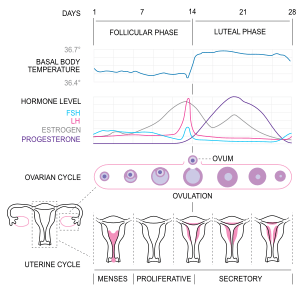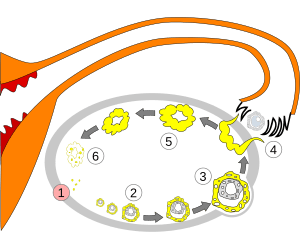Menstrual cycle facts for kids
The menstrual cycle is a natural process that happens in the bodies of girls and women. It usually repeats about every 28 days. During this time, a woman's body gets ready for a possible pregnancy. Her ovaries create a mature egg, and the inside of her uterus gets thicker. If a pregnancy doesn't happen, the egg and the thick lining of the uterus leave the body. This is called menstruation, or a period.
Four main hormones control the menstrual cycle: follicle-stimulating hormone (FSH), luteinizing hormone (LH), estrogen, and progesterone. These hormones work together to prepare the uterus to receive a fertilized egg and help it grow.
The menstrual cycle has three main stages: the Follicular stage, Ovulation, and the Luteal stage. The cycle stops if a woman becomes pregnant, as the fertilized egg attaches to the lining of the uterus.
Contents
What Happens in the Follicular Stage?
This stage is the very beginning of the menstrual cycle. It is counted as day one. It starts when the levels of progesterone and estrogen in a woman's blood go down. This drop causes the thick lining of the uterus, called the endometrium, to leave the body. This is what we call a period, and it looks like bleeding from the vagina. This part of the cycle usually lasts for about 4 to 6 days.
At the start of this stage, a small gland in the brain, called the pituitary gland, begins to release more follicle-stimulating hormone (FSH). This continues for a few days. FSH helps several small sacs, called follicles, to grow in one of the ovaries. Each follicle holds an immature egg. These growing follicles then start to make estrogen.
Usually, the amount of FSH in the body is highest around the third or fourth day of a period. After this, all but one of the follicles stop growing and disappear. The one remaining follicle grows larger and releases even more estrogen. This extra estrogen makes the lining of the uterus grow thick again. Near the end of this stage, estrogen levels are at their highest. This high level of estrogen causes the pituitary gland to release luteinizing hormone (LH), which also peaks around this time.
What is Ovulation?
Ovulation usually happens around day 14 of the cycle. This is when a mature egg is released from the ovary into the fallopian tube. It is now ready to be fertilized.
Ovulation happens because of the rise in estrogen and the peak in luteinizing hormone (LH) at the end of the follicular stage. The increasing LH levels help the egg inside the follicle to become fully mature. The follicle that holds the egg swells up and then breaks open. The egg is then released into the fallopian tube. The cells left behind from the broken follicle will change into an important structure called the corpus luteum in the next stage.
During ovulation, a woman's body temperature usually goes up by about 0.5 degrees Celsius.
What Happens in the Luteal Stage?
After the egg is released, the leftover cells from the follicle form the corpus luteum. This new structure starts to release progesterone into the body. This hormone makes the lining of the uterus (the endometrium) get even thicker. It becomes ready to receive a fertilized egg.
If an egg is fertilized, it happens during this stage.
If the Egg is Fertilized
If the egg is fertilized during ovulation, it becomes a zygote. This zygote then begins to divide and make many copies of itself. It also travels from the fallopian tube into the uterus. The levels of estrogen and progesterone in the body stay high. The zygote grows into an embryo and then attaches itself to the thick lining of the uterus. This is when a placenta starts to form and grow.
Once a pregnancy begins, the menstrual cycle stops. This allows the embryo to continue growing for the next nine months. The levels of progesterone and estrogen will remain high until the baby is ready to be born. After giving birth, a woman's menstrual cycle will eventually return to how it was before she became pregnant.
If the Egg is Not Fertilized
If the egg is not fertilized, the corpus luteum (the structure that was making progesterone) starts to break down around day 22 of the cycle. When this happens, the levels of both progesterone and estrogen in the body begin to drop. The amounts of these hormones are at their lowest around the 28th day of the menstrual cycle. When the hormone levels are low, the cycle then begins again with the follicular stage.
See also
 In Spanish: Ciclo menstrual femenino para niños
In Spanish: Ciclo menstrual femenino para niños



